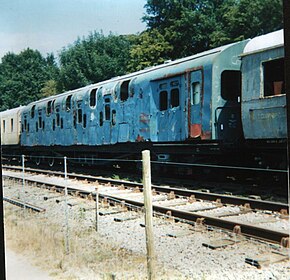SR class 4DD
| Southern Railway 4-DD | |
|---|---|
| Numbering: | 4001 + 4002 |
| Number: | 2 compositions (4 railcars 4 passenger cars) |
| Manufacturer: | Lancing and Estiegh Works, English Electric |
| Year of construction (s): | 1949 |
| Retirement: | 1971 |
| Gauge : | 1435 mm ( standard gauge ) |
| Length over buffers: | 78,448 mm |
| Height: | 3886 mm |
| Width: | 2820 mm |
| Service mass: | 39.626 t (railcar) 28.449 t (passenger car) 136.15 t composition |
| Driving wheel diameter: | 3 ' |
| Power system : | 750 volts = |
| Power transmission: | lateral power rail |
| Train brake: | electro-pneumatic |
| Coupling type: | UIC screw coupling |
| Seats: | 502 including folding seats |
| Standing room: | 150 total of 552 passengers |
| Floor height: | 1121 mm |
As Class 4DD the two are double-deck electrical multiple units designated that the Southern Railway was produced and in 1949 by the British Railways were put into operation. The vehicles were designed by Oliver Bulleid and, as a special feature, had nested passenger compartments. The 4DD were decommissioned in 1971. The two motor cars of the multiple units are still preserved, but not the passenger cars that go with them.
history
The Southern Railway had a space problem in the commuter trains around Dartford after the Second World War due to the increase in passengers. The eight-part electric multiple units (class 405) were regularly overcrowded. However, since the length of the platform was also limited, attempts were made to solve the problem by increasing the capacity. However, since the narrow English clearance profile does not allow double-deck coaches, a trick had to be used in order to be able to offer more seats with the same train length. This was achieved by placing a raised compartment between two compartments with English doors. This resulted in a 50% higher number of seats than with a normal, one-story arrangement. You sat in the raised compartment above the seats in the compartment below. The raised compartment was accessed by stairs from a compartment below. The windows in the upper compartment had to be made permanent for safety reasons and were provided with forced ventilation. With this ventilation, however, one did not achieve a satisfactory climate and therefore there were always complaints. The downtime on the platform also increased by 38%, since up to twice the number of people had to use a single door compared to the single-story version. The vehicles were also larger than the standard clearance profile and were therefore not allowed to be used freely. Therefore, it stayed with these two compositions and instead procured extended, one-story train compositions (class 415/6), which were extended by one car, with which one could form ten-car compositions.
The railcars could have operated in multiple control with other single-story railcars, but because of the operational restrictions they usually ran together as an 8-car composition, and only on the routes around Dartford.
construction
Two railcars formed a four-part unit with two cars each, although only the railcar had a driver's cab on one side and was therefore dependent on a second railcar. In addition to a multifunctional compartment (luggage and passengers), the railcars had 5 lower and 4 upper compartments, while the passenger cars had 7 lower and 6 upper compartments. A half-train thus offered 508 seats. They were very narrow, however, as it was assumed that up to 11 people were occupied in a normal compartment.
The undercarriages of the vehicles largely corresponded to the previous multiple units, only smaller wheels were installed (3 'instead of 3'2' '), but the solebar between the bogies was not lowered. The electrical equipment was installed under the floor.
On the lower deck, the wagons had a floor height of 1121 mm above the top of the rails. This height can partly be explained by the high staff.
Train formation
| Composition number | Motor vehicle (DMBT) | Passenger car (TT) | TT | DMBT | delivery |
|---|---|---|---|---|---|
| 4001 (later 4901) | 13001 | 13501 | 13502 | 13002 | September 1949 |
| 4002 (later 4902) | 13003 | 13503 | 13504 | 13004 | October 1949 |
